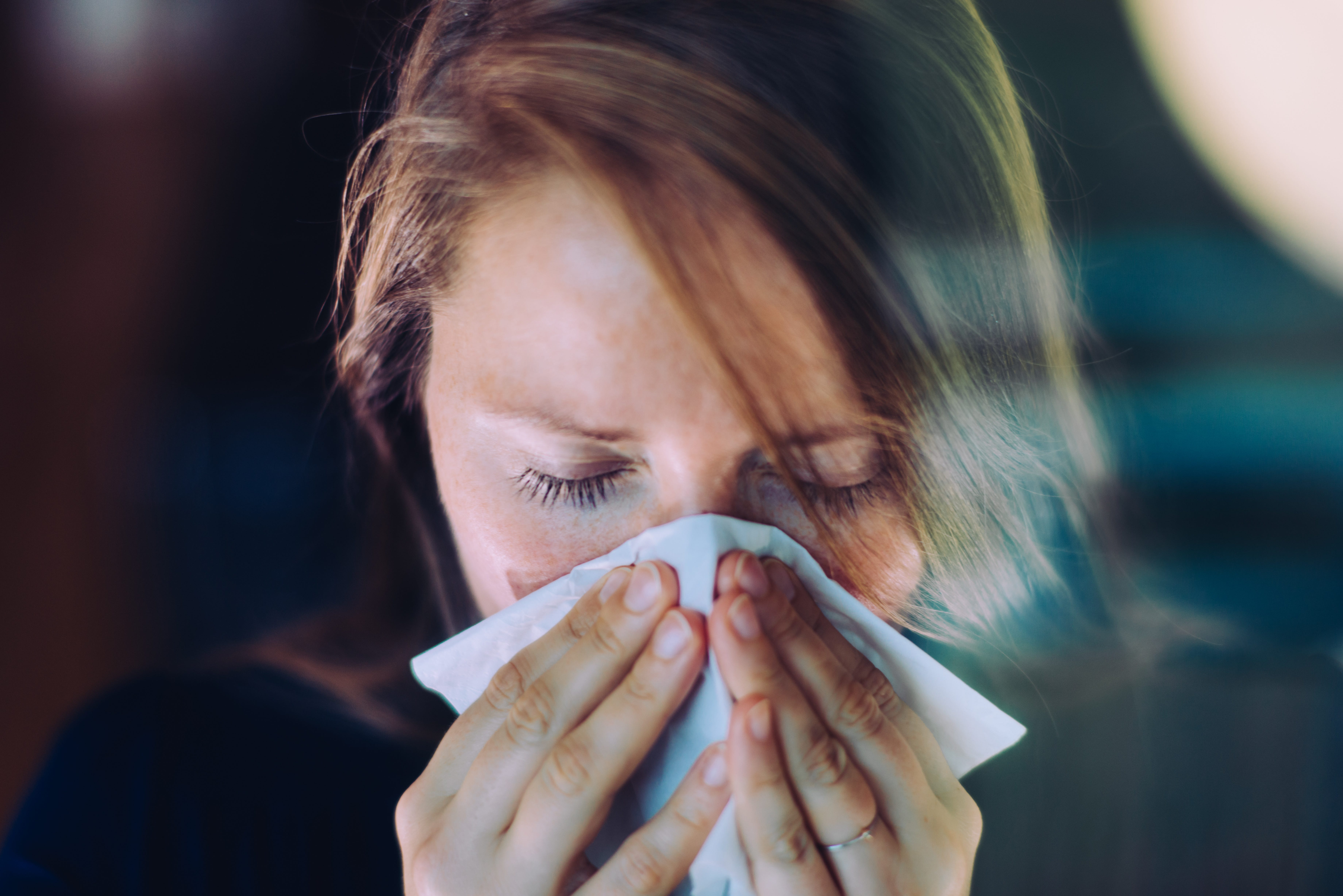
Common cold
Colds are caused by more than 200 different viruses, including
strains of coronavirus and, more commonly,
rhinoviruses. While miserable and exceedingly common, a cold is rarely as debilitating as the flu.
Frequency
Common symptoms
A gradual progression often starting with a sore throat, leading to sneezing, runny nose, stuffiness, and the annoying postnasal drip (that’s
mucus running down your throat, attempting to wash the infection away).
Possible complications
How it spreads
Through the air from a cough or sneeze, from the hands of an infected person, from hard surfaces, and via close contact with an infected person.
Contagious period
Influenza
Despite understandable fears of outbreaks like coronavirus, various strains of
the flu — there are 29 different subtypes — cause far more deaths every year than most other viral outbreaks do across several years.
Frequency
About 8% of the U.S. population comes down with a flu bug every year. On average, it
kills 12,000 to 61,000 Americans annually.
Common symptoms
Quick onset of fever over 100.4 degrees Fahrenheit, aching muscles, and chills are the characteristic signs.
Possible complications
Ear and sinus infections, pneumonia, worsening of chronic medical conditions, and death. As with other viruses, the flu tends to be
most problematic for the young, the old, and anyone with a compromised immune system.
How it spreads
Through the air from a cough or sneeze, from the hands of an infected person, from hard surfaces, and via close contact with an infected person.
Cold and flu viruses can survive for 15 to 20 minutes on the skin and several hours on hard surfaces.
Contagious period
Norovirus
This fast-acting germ, often incorrectly called “stomach flu,” inflames the stomach or intestines and leads to intense but typically short-lived gastrointestinal discomfort. It’s the
leading cause of outbreaks of
food poisoning in the United States (more common than bacterial outbreaks from salmonella or E. coli).
Frequency
About
20 million Americans, or 6% of the population, suffer an acute case of norovirus-induced gastroenteritis each year.
Common symptoms
Unlike cold or flu viruses, norovirus brings on sudden, often severe and frequent vomiting and/or diarrhea.
Possible complications
Dangerous dehydration. Some 400,000 U.S. norovirus cases annually lead to emergency room visits, with children predominating. Between 570 and 800 patients die—mostly kids, older people, and people with compromised immune systems.
How it spreads
Most notoriously through
human poop and vomit (including airborne puke droplets). A droplet of diarrhea the size of a pinhead
can contain enoughnorovirus particles to make someone else sick. The disease is often transmitted by food harvested in contaminated water, or it’s passed along at a restaurant or at home by an infected person preparing food served raw or touching food after it’s cooked.
Contagious period
COVID-19 coronavirus
Symptoms of
the new coronavirus, called COVID-19, are virtually indistinguishable from influenza, health experts say so far, and can range from mild and even almost unnoticed for some people to severe and deadly for others. (Scientists can’t yet explain why, but such varied reactions also occur with other viral diseases.)
Frequency
Extremely rare in the United States as of this writing. If COVID-19 is not widespread where you live or visit, then your odds of having it are next to nil.
Most common symptoms
Fever, cough, and shortness of breath.
Possible severe complications
Pneumonia, severe acute respiratory syndrome, kidney failure, death.
How it spreads
Through the air from a cough or sneeze, from hard surfaces, and via close contact with an infected person (within six feet, the CDC says). Also,
apparently in human feces, according to a study published February 17 in the journal
Emerging Microbes and Infections, plus
one other previous study and
another one announced since. Researchers fear that the spread through poop and the potential for the disease to cause diarrhea could be aiding rapid transmission.
Contagious period
Possibly before symptoms start, but
mostly when symptoms are present. (The specifics are not yet known to science.)
Emerging view of coronavirus symptoms
Because the COVID-19 coronavirus emerged only in December, the CDC has yet to pin down the various symptoms, or their prevalence, beyond the three most common. “We do not have any more specifics at this time, because there has been a range of possible symptoms for people with COVID-19,” CDC spokesperson Richard Quartarone tells Elemental.
However, researchers recently studied 138 people with advanced cases of the virus who had been hospitalized with pneumonia after being infected with COVID-19 in Wuhan, China. The research,
published February 7 in
JAMA, revealed preliminary data showing the percentage of patients with these symptoms:
- Fever: 98.6%
- Fatigue: 69.6%
- Cough: 59.4%
- Aches: 34.8%
- Difficulty breathing: 31.2%
- Nausea: 10.1%
- Diarrhea: 10.1%
- Headache: 6.5%
- Vomiting: 3.6%
But these were patients with severe symptoms, and nearly half of them had preexisting medical conditions, including hypertension, diabetes, and heart disease, so the figures may not represent how the disease typically manifests in healthy individuals.
In other
research recently published by the Chinese Center for Disease Control and Prevention, 81% of 44,672 coronavirus cases were mild, including some in which symptoms were like a minor flu and others that were like a minor cold. The overall fatality rate in the study was 2.3%, but outside Hubei Province, the epicenter of the outbreak, the fatality rate was 0.4%. For comparison, the fatality rate for seasonal flu is around 0.1%.
Serious symptoms
A big caveat to all symptom spotting: No given disease presents the same in each person or each case, and there are many different strains of cold, flu, and norovirus with different degrees of impact. Sometimes fever does not accompany influenza, for example. Symptoms that are rare can occur. Children, the elderly, and anyone with existing health issues may experience more severe symptoms than others. Among the
list of a dozen serious symptoms that should trigger immediate medical attention:
- Seizures
- Chest pains
- Trouble breathing or fast breathing
- Fever lasting more than four days or rising above 104 degree Fahrenheit
- Conditions that lasts beyond typical duration
- Conditions that improve then worsen
- Severe dehydration
- Bluish lips or face
And there are, of course, many other diseases that may seem cold- or flu-like at the outset but require prompt medical attention. Among them:
- Measles may start out with mostly cold-like symptoms but is accompanied by a rash and tends to spike a fever to 104 degrees Fahrenheit.
- Mumps starts out flu-like but typically swells the salivary glands, causing puffy cheeks and a swollen jaw.
- Strep throat tends to start quickly with a sore throat and painful swallowing. (Strep is a bacterial infection, not a virus, that can be treated effectively with antibiotics, which don’t work on viruses.)
Seasonal allergies can also mimic cold and flu symptoms. But they’re often marked by itchy, watery eyes, which are not common to colds, the flu, or other infectious diseases. Allergies do not trigger headaches or muscle aches. And, of course, allergies can last weeks.
Spread the word, not the virus
Viruses have evolved over millions of years to be supremely capable of surviving outside a host and infecting another — to go viral — simply by floating through the air inside the mucus of a cough or sneeze. Even
talking can unleash virus-containing droplets seeking a new host. “These droplets can land in the mouths or noses of people who are nearby or possibly be inhaled into the lungs,” the CDC
says.
Viruses can also spread when an infected person touches their face and then shakes a hand, turns a doorknob, or prepares food. Cold and flu viruses can
survive for 15 to 20 minutes on the skin and several hours on hard surfaces. New research on COVID-19 suggests this coronavirus
might survive for a few days on surfaces.
If you think you’re getting sick, or if you have a fever or are coughing, sneezing or vomiting:
- Stay home and keep it to yourself.
- Avoid touching your eyes, nose, and mouth.
- Cough or sneeze into your elbow, not your hands.
- Disinfect doorknobs, countertops, cooking utensils, toys — any hard surfaces likely to transmit germs.
- Frequently wash your hands properly, scrubbing with soap and water for 20 seconds. (Hand sanitizers can be helpful, but only in a pinch and if used properly.)
- And, sorry, but avoid shaking hands, hugging, and even kissing. (Yes, while saliva has antibodies and enzymes that reduce the risk of passing many viruses, you can catch a cold, the flu, and other bugs by kissing, saysMichael Benninger, MD, of the Cleveland Clinic. Other experts agree.)
If you feel desperately ill, have any of the serious signs mentioned above, or suspect coronavirus because you visited an area with an outbreak or have been around someone diagnosed with the disease, put down that great book, forget the chicken soup, and call your doctor immediately or get to an emergency room.
 PA Images/SWNS
PA Images/SWNS SWNS
SWNS Pexels
Pexels Pexels
Pexels PA Images
PA Images



